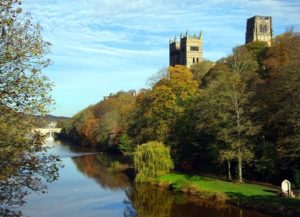Set high above an incised meander in the River Wear, Durham Cathedral is regarded as one of the finest examples of Norman architecture in the country. The views from Prebends Bridge and along the river banks provide some of the classic shots of the cathedral.
The splendid Norman building replaced an earlier church, built to hold the body of St Cuthbert. When Cuthbert died in 687 he was buried on Lindisfarne, Holy Island. The monastery became very rich from gifts bestowed by pilgrims to the shrine. The Vikings made many raids on the monastery forcing the monks to flee taking the coffin of St Cuthbert with them. The coffin was carried around the north east for over a hundred years before being buried in a newly built church at Durham.
According to the legend, the vehicle carrying the coffin came to a standstill and no-one could get it to move. After a period of fasting and meditation, St Cuthbert appeared in a vision to one of the monks saying the coffin should be taken to a place called Dunholm. The monks were now able to move the coffin, although they had no idea where Dunholm was. By chance a few days later, they heard a milkmaid asking another milkmaid if she had seen her dun cow that had wandered off. The other replied she had seen the cow roaming near Dunholm. The monks followed the milkmaids to where they found the dun cow. This place became the site for a new church for the body of St Cuthbert in AD995. The story is remembered by an C18th carving of two milkmaids and a cow on the north west corner of the Chapel of the nine Altars. Legend or no legend, this was an excellent spot to rebury the body as the peninsula was a very defensive site set high above the river with only a narrow neck to defend. A simple stone church was built in AD998 housing a community of Benedictine monks and soon became a site of pilgrimage.
There is nothing left of the original church. The present building was built by William of Calais who was appointed Prince Bishop by William the Conqueror in 1080. Construction began in 1089 and continued until 1140 when the nave, quire, and two transepts had been built. These have the typical round Norman windows and heavily carved Norman doorways. The Galilee Chapel was added in 1175. The two west towers were built between 1217-26.
The central tower dates from the same time, but was struck by lightning and had to be rebuilt in 1429. It was struck again thirty years later and had to be completely rebuilt between 1465-74 with tall lancet windows. The top was added ten years.
The Chapel of the nine Altars was added to the east end between 1242-1280 and was built in the completely different Gothic style.
After the Dissolution of the Monasteries in 1539, the Cathedral was re-founded with the last prior becoming the first dean. Twelve former monks became canons. The wall paintings were covered with whitewash, Cuthbert’s shrine was destroyed and the stained glass broken.
After the Civil War, the Cathedral was closed and used by Cromwell to hold 3000 Scottish prisoners. They burnt much of the surviving woodwork to keep themselves warm. Prior Castell’s clock in the south transept is said to have survived because it had a thistle on it.
After the Restoration, Bishop Cosins, a former canon refurbished the church. The glorious woodwork in the quire dates from this time.
The cathedral still has some of the best surviving monastic buildings with the cloisters, chapter house (rebuilt in C19th), great kitchen, undercroft and the monk’s dormitory still surviving.
The Undercroft is now the shop and tea room.
When we visited in October 2014, the C14th monk’s dormitory and great kitchen were closed as they are being developed into a state of the art exhibition centre.
The cathedral can either be approached from the south by Palace Green which was the original market place with the entrance to the castle off it. This takes you through the massive south door with its rows of chevron carving and sanctuary knocker with its head with medusa like arms round it.
The other entrance is via College Green on the north side. This was the former outer court of the monastery. Following the Dissolution, the buildings were converted to provide accommodation for the Dean and twelve Prebends. The Bishop originally lived in Durham castle, before moving to Auckland Castle, twelve miles to the south of Durham.
This takes you into the cloisters, past the undercroft with shop and restaurant and in through one of the south doors off the cloisters. Although smaller and less ornate than the north door, they have round pillars with carved capitals and several rows of Norman carving around the round arches above the door.
Unfortunately photography isn’t allowed in the cathedral. I have written a detailed review of the inside here.
ACCESSIBILITY
There are traffic restrictions on vehicle entry to the historic centre of Durham on the peninsula There is no parking on Palace Green. There is limited disabled parking behind the cathedral. Contact the duty porter on arrival for help. Alternatively there is some disabled parking further down the Bailey.
The Cathedral bus runs a thirty minute service between the railway station, market place and some car parks to Palace green.
There is level access into the cathedral and ramped access to the quire via the north aisle. There are steps down into the Chapel of the Nine Altars and a flight of steps up to St Cuthbert’s Shrine. There is a stairclimber which can be used by manual wheelchairs. Contact the cathedral in advance to make sure a trained person is available to help.
Websites:
http://www.durhamcathedral.co.uk/
http://www.durhamworldheritagesite.com/architecture/cathedral
There are more pictures here.








